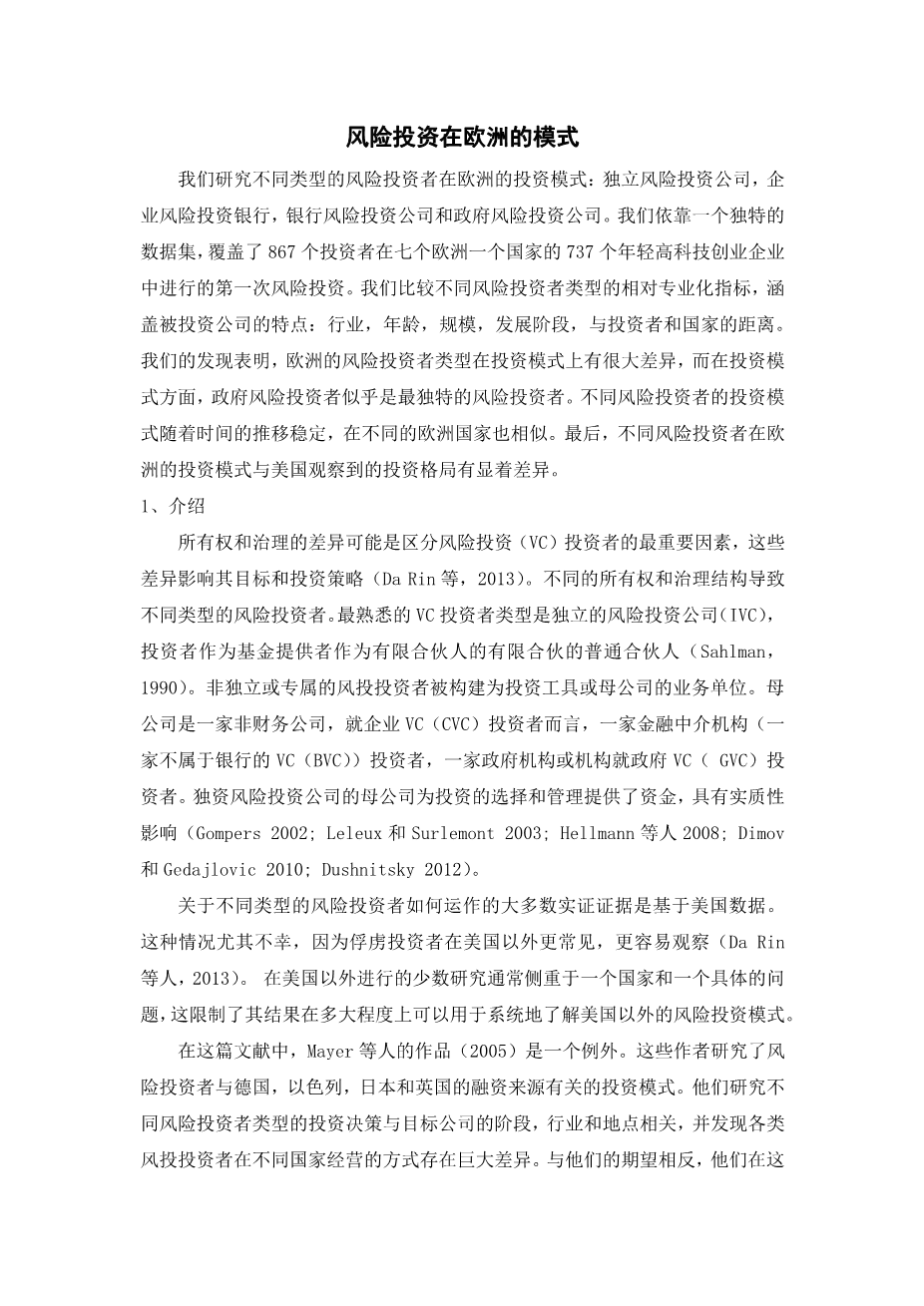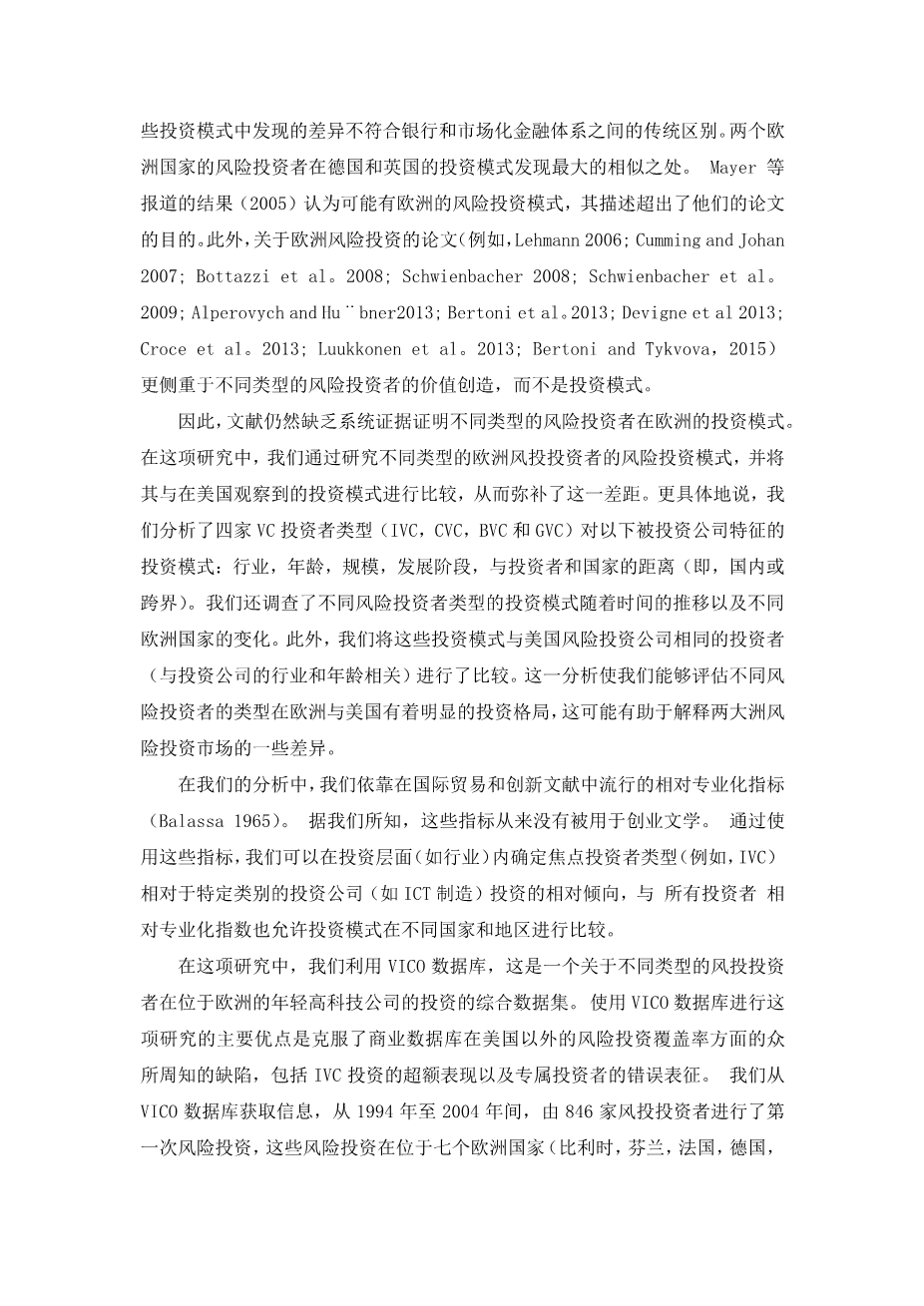The patterns of venture capital investment in Europe
We study the investment patterns of different types of venture capital (VC) investors in Europe: independent VC, corporate VC, bank-affiliated VC and governmental VC. We rely on a unique dataset that covers 1663 first VC investments made by 846 investors in 737 young high-tech entrepreneurial ventures in seven Europe an countries. We compare the relative specialization indices of the different VC investor types across several dimensions that characterize investee companies: industry, age, size, stage of development, distance from the investor and country. Our findings indicate that VC investor types in Europe differ substantially in their investment patterns when compared to one another and that, in terms of investment patterns, governmental VC investors appear to be the most distinct type of VC investor. The investment patterns of different VC investors are stable over time and similar across different European countries. Finally, the investment patterns of the different VC investor types in Europe are significantly different from those observed in the USA.
1 Introduction
Differences in ownership and governance are arguably the most important factor differentiating venture capital (VC) investors, and these differences influence their objectives and their investment strategies (Da Rin et al. 2013). Different configurations of ownership and governance give rise to different types of VC investors. The most familiar VC investor type is the independent VC (IVC), an investor acting as general partner in a limited partnership in which the fund providers serve as limited partners (Sahlman 1990). Non-independent, or captive, VC investors are structured as investment vehicles or as business units of a parent company. The parent company is a nonfinancial company in the case of a corporate VC (CVC) investor, a financial intermediary in the case of a bank-affiliated VC (BVC) investor, and a governmental agency or body in the case of a governmental VC (GVC) investor. The parent company of a captive VC investor provides capital and has substantial influence on the selection and management of investments (Gompers 2002; Leleux and Surlemont 2003; Hellmann et al. 2008; Dimov and Gedajlovic 2010; Dushnitsky 2012).
Most of the empirical evidence regarding how different types of VC investors operate is based on US data. This circumstance is particularly unfortunate because captive investors are more common, and thus easier to observe, outside of the USA (Da Rin et al. 2013). The few studies conducted outside of the USA typically focus on a single country and one specific dimension of the issue, which limits the extent to which their results can be used to obtain a systematic view of the patterns of VC investment outside of the USA.
In this stream of the literature, the work by Mayer et al. (2005) is an exception. These authors study the investment patterns of VC investors in relation to their source of financing in Germany, Israel, Japan and the United Kingdom. They examine the investment decisions of different VC investor types as related to the stage, industry and location of the target company and find substantial differences in the ways in which the various types of VC investors operate in different countries. Contrary to their expectations, the differences that they find in these investment patterns do not follow the conventional distinction between bank- and market-based financial systems. The greatest similarities are found in the investment patterns of VC investors in the two European countries in their study (Germany and the United Kingdom). The results reported by Mayer et al. (2005) suggest that there might be a European pattern of VC investment, the description of which is beyond the aim of their paper. Moreover, the papers on VC in Europe (e.g., Lehmann 2006; Cumming and Johan 2007; Bottazzi et al. 2008; Schwienbacher 2008; Schwienbacher et al. 2009; Alperovych and Hu ¨bner 2013; Bertoni et al. 2013; Devigne et al. 2013; Croce et al. 2013; Luukkonen et al. 2013; Bertoni and Tykvova ´ 2015) have focused more on value creation by different types of VC investors than on their investment patterns.
As a result, the literature still lacks systematic evidence of the investment patterns of different types of VC investors in Europe. In this study, we contribute to filling this gap by examining the patterns of VC investment across different types of VC investors in Europe and comparing them with the investment patterns observed in the USA. More specifically, we analyze the investment patterns of four VC investor types (IVC, CVC, BVC and GVC) with respect to the following investee company characteristics: industry, age, size, stage of development, distance from the investor and country (i.e., domestic or cross-border). We also investigate how the investment patterns of different VC investor types vary over time and across different European countries. In addition, we compare these investment patterns with those exhibited by the same four types of VC investors in the USA (relating to industry and age of the investee company). This analysis allows us to assess whether different VC investor types have a distinct investment pattern in Europe compared with the USA, which could contribute to explaining some of the differences in the VC market in the two continents.
In our analysis, we rely on relative specialization indices (Balassa 1965), which are popular in the international trade and innovation literature (see Sect. 3). To the best of our knowledge, these indices have never been used in the entrepreneurial finance literature. By using these indices, we can determine, within an investment dimension (e.g., industry), the relative propensity of a focal investor type (e.g., IVC) to invest in a particular category of investee company (e.g., ICT manufacturing) in comparison with all investors. Rel
剩余内容已隐藏,支付完成后下载完整资料


英语译文共 10 页,剩余内容已隐藏,支付完成后下载完整资料
资料编号:[487044],资料为PDF文档或Word文档,PDF文档可免费转换为Word


